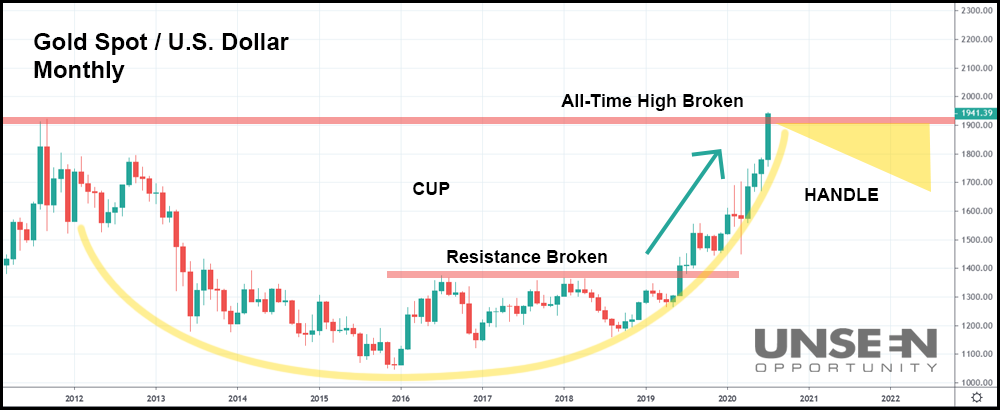Stocks are up and Big Tech is back. That’s the word on Wall Street this morning as investors prepare for new coronavirus stimulus measures and another week of critical corporate earnings.
Leading the market are mega-caps Apple (NASDAQ: AAPL) and Amazon (NASDAQ: AMZN), which have already risen more than 2% as of noon. FAANG peers Facebook (NASDAQ: FB), Netflix (NASDAQ: NFLX), and Google parent company Alphabet (NASDAQ: GOOG) are trading 1% higher as well.
Surprisingly, gold is surging, too. Strong performances from precious metals have accompanied a soaring market over the last few years.
It seems that the relationship between the two asset classes continues.
Pushing gold higher today is lingering concern over Covid-19 and further rounds of unprecedented stimulus. The central banks of the world intend on providing indefinite relief to coronavirus-stricken economies, placing significant inflationary pressure on currencies.
“Gold bugs” – precious metals traders – have long awaited the death of the dollar. Now, it seems that more traditional investors are also expecting a fiat currency collapse – something that could potentially happen with U.S.-China tensions worsening.
If a “capital war” breaks out, the dollar may be the first casualty according to Bridgewater Associates founder and economist Ray Dalio.
“If you say, by law, don’t invest in China or even possibly withholding the payment of bonds that the United States owes payment on in China, these things are possibilities and they have big implications such as for the value of the dollar because investors, premarket investors, are not used to having those things dictated by the government,” said Dalio.
“So, these are difficult questions that have to be well-addressed at this time.”
Overall, gold’s been on a tear since early 2018 thanks to the U.S.-China trade war. The precious metal hit some turbulence during the coronavirus crash, but ultimately recovered and now rests squarely above key resistance at its all-time high.
An even weaker dollar should see it rise further.
But that doesn’t mean it will do so indefinitely. In fact, gold could actually enter the famous “cup and handle” formation in the third and fourth quarters as volatility rears its head in equities.

In the monthly candlestick chart above, which shows the gold spot price since 2012, the “cup” portion of the formation has already completed.
What comes next could very well be the “handle,” preceding either another leg up or, conversely, a leg down.
Cup and handle formations are usually identified on daily stock charts. It’s not often that you see them on precious metals charts, let alone in terms of monthly candlesticks.
Gold could absolutely go higher in June, but it’ll have plenty of work to do if it’s going to escape the pull of the cup and handle. Many analysts are predicting a broad, market-wide correction (if not a crash). The last time that happened – in March – gold sunk as well due to a lack of buyers.
If the equity crunch arrives next month, gold will fall into the handle. If it’s able to break above the all-time high once more, historical performance suggests another leg up is to be expected.
But if it drops below the handle’s low, a gold rout could follow.
Either way, gold’s in a precarious spot for prospective buyers. Owners of gold, meanwhile, continue cheering its ascent.
Regardless of which one you are, though, the fact remains that any gold trading in the next few months needs to be handled with extreme caution. Jumping out too early could exclude you from a record-setting gold boom.
Holding it too long, on the other hand, would end in tears if gold returns to its 2016-2017 levels.
So, watch and see if the handle starts to form toward the end of the year. If it does, keep an eye on the handle highs and lows, because a breakout past one or the other will likely determine gold’s moderate-to-long-term future.








